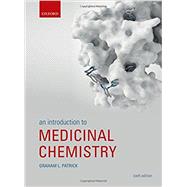
An Introduction to Medicinal Chemistry
by Patrick, Graham-

Free Shipping on all Orders Over $35!*
*excludes Marketplace items.
-
 We Buy This Book Back!
We Buy This Book Back!
Rent Textbook
Rent Digital
Downloadable: 180 Days
Downloadable: 365 Days
Downloadable: Lifetime Access
New Textbook
We're Sorry
Sold Out
Used Textbook
We're Sorry
Sold Out
This item is being sold by an Individual Seller and will not ship from the Online Bookstore's warehouse. The Seller must confirm the order within two business days. If the Seller refuses to sell or fails to confirm within this time frame, then the order is cancelled.
Please be sure to read the Description offered by the Seller.
Summary
An Introduction to Medicinal Chemistry, sixth edition, provides an accessible and comprehensive account of this fascinating multidisciplinary field. Assuming little prior knowledge, the text is ideal for those studying the subject for the first time. Part one of the book introduces the principles of drug action via targets such as receptors and enzymes. The book goes on to explore how drugs work at the molecular level (pharmacodynamics), and the processes involved in ensuring a drug meets its target (pharmacokinetics). Further sections cover the processes by which drugs are discovered and designed, and what has to happen before a drug can be made available to the public. The book concludes with a selection of current topics in medicinal chemistry, and a discussion of various key drug groups. The subject is brought to life throughout by engaging case studies highlighting particular drugs and the stories behind their discovery and development.
The Online Resource Centre features:
For students:
DT Multiple Choice Questions to support self-directed learning
DT Web articles describing recent developments in the field and further information on topics covered in the book
DT Journal Club to encourage students to critically analyse the research literature
DT Molecular Modelling Exercises, with new exercises in Chem3D
DT New assignments to help students develop data analysis and problem solving skills
For registered adopters of the book:
DT A test bank of additional multiple-choice questions, with links to relevant sections in the book
DT Answers to end-of-chapter questions.
DT Figures from the book, ready to download.
DT Power Point slides to accompany every chapter in the book.
Author Biography
Graham Patrick, Lecturer in Organic Chemistry and Medicinal Chemistry, University of the West of Scotland
Dr Graham Patrick gained his BSc Honours at Glasgow University, winning the McKay-Smith Prize for Chemistry. He completed his PhD with Professor Kirby and Professor Robins studying the biosynthesis of gliotoxin and related fungal metabolites. Following this, he worked in the pharmaceutical industry as a research chemist and radiochemist on a variety of projects that included topic areas such as opioids, antibacterial agents and antidepressants.
His academic career has included positions at Leeds and Strathclyde Universities as well as the Australian National University. He joined the University of Paisley (now the University of the West of Scotland) in 1990, teaching medicinal chemistry and drug design.
Table of Contents
1. Drugs and drug targets - an overview
Part A Drug targets - structure and function
2. Protein structure and function
3. Enzymes: structure and function
4. Receptors: structure and function
5. Receptors and signal transduction
6. Nucleic acids: structure and function
Part B Pharmacodynamics and pharmacokinetics
7. Enzymes as drug targets
8. Receptors as drug targets
9. Nucleic acids as drug targets
10. Miscellaneous drug targets
11. Pharmacokinetics and related topics
Case study 1: Statins
Part C Drug discovery, design, and development
12. Drug discovery: finding a lead
13. Drug design: optimizing target interactions
14. Drug design: optimizing access to the target
15. Getting the drug to market
Case study 2: The design of ACE inhibitors
Case study 3: Artemisinin and related antimalarial drugs
Case study 4: The design of oxamniquine
Part D Tools of the trade
16. Combinatorial synthesis
17. Computers in medicinal chemistry
18. Quantitative structure-activity relationships (QSAR)
Case study 5: De novo design of a thymidylate synthase inhibitor
Part E Selected topics in medicinal chemistry
19. Antibacterial agents
20. Antiviral agents
21. Anticancer agents
22. Cholinergics, anticholinergics, and anticholinesterases
23. Drugs acting on the adrenergic nervous system
24. Opioid analgesics
25. Antiulcer agents
26. Cardiovascular drugs
Case study 6: Steroidal anti-inflammatory agents
Case Study 7: Design of a novel antidepressant
Case Study 8: The design and development of aliskiren
Case Study 9: Factor Xa inhibitors
Case Study 10: Reversible inhibitors of HCV NS3-4A protease
Appendices
An electronic version of this book is available through VitalSource.
This book is viewable on PC, Mac, iPhone, iPad, iPod Touch, and most smartphones.
By purchasing, you will be able to view this book online, as well as download it, for the chosen number of days.
A downloadable version of this book is available through the eCampus Reader or compatible Adobe readers.
Applications are available on iOS, Android, PC, Mac, and Windows Mobile platforms.
Please view the compatibility matrix prior to purchase.
